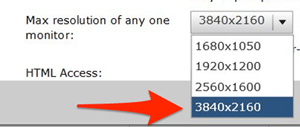In-Depth
VMware View Now Supports 4K Monitors
Here are the main considerations to determine whether or not it's for you.
VMware has announced virtual desktop support in View for 4K monitors, as part of the upgrades in Horizon 6.2. The ability to use 4K monitors in a View 6.2 environment is an interesting proposition. Currently, 1080p monitors are the standard for desktops, but the lure of 4K desktops is strong; with four times as many pixels as a 1080p desktop (8 million vs. 2 million), 4K monitors have a resolution of 3840 x 2160. The result, as anyone who has seen a 4K monitor will tell you, is a much sharper display which allows the use of larger monitors.
 [Click on image for larger view.]
Figure 1. 3840 resolution; it's a beautiful thing.
[Click on image for larger view.]
Figure 1. 3840 resolution; it's a beautiful thing.
Photo and video editors, CAD users, the medical community and gamers have been the early adopters of 4K monitors due to their superior image quality. However, general purpose users will enjoy the increased real estate that 4K monitors can offer. The cost of 4K monitors range from $500 to $3,000; for example, a nice 24" Dell Ultra HD monitor costs $799.
But before rushing out and buying 4K monitors for your Horizon users, there are a few things to consider:
- Network bandwidth. Will pushing four times the number of pixels from your virtual desktop to your View monitor consume four times the network bandwidth? It really shouldn't, as currently most heavy content, like videos, are created in 1080p and won't require any more bandwidth. Other content running in a 4K environment, such as office documents, should have a mostly negligible effect on bandwidth consumption. PC-over-IP (PCoIP) does an excellent job with compression and image optimization, so even if the object does have high DPI, PCoIP will deal with it elegantly, even during bandwidth congestion.
- Display. Most sub-$1,000 4K monitors use twisted-nematic (TN) panels rather than in-plane-switching (IPS) panels for their monitors. TN panels have quicker refresh rates, but compared to IPS monitors the viewing angles aren't as good; the colors tend to be washed out as they don't have as great an array of colors as IPS. You need to compare the two technologies side by side, running your applications, to see if the lower cost of TN offsets the superior display quality of IPS monitors.
- Application support. If you have applications that use pixel-based icons and menus, they'll appear at one-fourth the size they do on a 1080p monitor. Most major software developers, including Microsoft, have introduced scaling technologies for their icons and menus. Newer apps deal well with 4K monitors, but running your older applications may be problematic. Make sure your applications are useable with 4K monitors.
- Graphic cards. 4K monitors require a graphics card that can support them. Only the most recent thin- and zero-clients will have a GPU that will be able to support 4K monitors. Before going out and buying a 4K monitor, make sure that your client -- whether it's thin, zero, or a repurposed PC -- has a GPU and display protocol to support it. VMware has said that its Windows native View Client (that runs on a PC) will support 4K monitors if the GPU does.
- Interface connector. The amount of bandwidth between a 4K monitor and a client's graphic card is immense: 12Gbps (1.5GBps). This bandwidth demands a protocol and interface connector that supports it. HDMI v1.4 and MHL 3 support 4K, but only at 30Hz. On the other hand, HDMI v2.0 and superMHL support 4K at 60Hz. If you use DisplayPort, you'll need 1.2 or 1.3 to support 4K at 60Hz.
4K monitor support requires Horizon client 3.5 and View Agent v6.2. Only a single monitor is supported with Aero on a Win7/Win8 virtual desktop, using with virtual hardware version 10. With virtual hardware version 11, three monitors will be supported on Win7 if Aero is disabled. Zero clients will be supported, but won't necessarily support High DPI scaling. The initial Windows client will not have DPI scaling, but the Mac client will. VMware will provide more guidance around video memory, which of their video options will support 4K monitors and bandwidth consumption when the product hits general availability.
Although there are many caveats about running 4K monitors with View, the end output can be stunning. If you have applications that support 4K resolution -- medical, engineering, image editing or even general office applications -- the benefits of running 4K monitors in your View can be well worth it.
Like any other technology, over time 4K monitors will inevitably become more mainstream and less expensive. As you begin your 4K journey, keep in mind: monitor type (TN or IPS), the refresh rate of the monitor (you want 60Hz), application support (pixel-based menus), display protocol (HDMI v1.4 or DisplayPort 1.2 or better), and the additional bandwidth that the network will need to get all that 4K goodness to your end user's monitor.
About the Author
Tom Fenton has a wealth of hands-on IT experience gained over the past 30 years in a variety of technologies, with the past 20 years focusing on virtualization and storage. He previously worked as a Technical Marketing Manager for ControlUp. He also previously worked at VMware in Staff and Senior level positions. He has also worked as a Senior Validation Engineer with The Taneja Group, where he headed the Validation Service Lab and was instrumental in starting up its vSphere Virtual Volumes practice. He's on X @vDoppler.